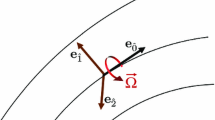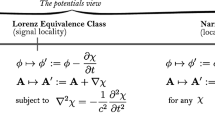Abstract
The development of tractable relationships for calculating the radiation produced by electric oscillators relied on a particular connection between the scalar potential, whose gradient is determined by charge density, and the vector potential, whose curl determines magnetic induction. Other such connections are permissible in electrodynamic field theory, including one used by Maxwell, but only one among them leads easily to radiation. Forms of electrodynamics other than Maxwell’s, including those by Kirchhoff, Helmholtz, Riemann and others, were not free to choose among such relationships, though none among these theories, with the limiting exception of Helmholtz’s, led to wavelike equations of propagation without assuming propagation a priori. One theory besides Maxwell’s that did was developed by the Danish physicist Lorenz. Although Lorenz derived the link between potentials later deployed for radiation in classical electrodynamics, his theory allowed no other choice. Three decades after Lorenz, the Dutch physicist Lorentz produced the first general understanding that the connection between the potentials can take various forms. Such a link was subsequently denominated a “gauge”, governed by the understanding that a particular choice, called a “gauge transformation”, must leave the measurable quantities of the theory unaltered. What follows traces the ways in which connections between the potentials were deployed in the nineteenth and early twentieth centuries.
Access this chapter
Tax calculation will be finalised at checkout
Purchases are for personal use only
Similar content being viewed by others
Notes
- 1.
On Maxwell’s field understanding of charge see (Buchwald 1985, 23–34).
- 2.
- 3.
- 4.
(Helmholtz 1858).
- 5.
- 6.
(Kirchhoff 1882a, 139) and (Kirchhoff 1882b, 159). On Weber see (Archibald 1989b). A modern account is (Assis 1994). See (Jackson and Okun 2001, 9–10) on Kirchhoff et al. Note that the difference in form between the Neumann and Kirchhoff potential functions vanishes for the interaction between closed circuits. The difference also vanishes if the divergence of the potential is zero.
- 7.
Rk results either from Kirchhoff’s form Ak of the vector potential or from the Neumann form AN given the same continuity equation. These two potentials have the same curl.
- 8.
(Kirchhoff 1882a, 140–41).
- 9.
In 1856 Weber and Rudolf Kohlrausch (1809-1858) found the constant c to have the value 4.39 ∗ 108m/s, which implied that the current propagates in such wires at speed 3.1042 ∗ 108m/s, which was close to the extant value for the speed of light.
- 10.
(Maxwell 1873), vol. 2, chap. 9.
- 11.
(Maxwell 1873, sectns. 585-591). Maxwell’s electrokinetic momentum per unit area is ∇ × A, derived from his expression for the circuit’s contribution to the field momentum as ∮A · dl, where A is introduced directly as such. He then asserted that ∇ × A represents “what we are already acquainted with as the magnetic induction” because the variation of this momentum density through the area surrounded by a circuit results in a force, and on “Faraday’s theory, the phenomena of electromagnetic force and induction in a circuit depends on the variation of the number of lines of magnetic induction which pass through the circuit” (sectn. 592).
- 12.
As noted by (Yaghjian 2014, 240).
- 13.
(Maxwell 1873, secs. 783–784). Note that in the Treatise Maxwell’s expression for ∇2 has the opposite sign to the modern one “in order to make our expressions consistent with those in which Quaternions are employed” (sec. 616). I follow modern conventions.
- 14.
(Maxwell 1873 sec. 783).
- 15.
(Yaghjian 2014, 244) points out that since the addition of the gradient of any function of r,t to A leaves B unaltered, it’s possible to add to ψ the term \( \frac{\partial -\int \psi \left(r,{t}^{\prime}\right)d{t}^{\prime }+t\int \left(\rho /\left|\textbf{r}-{\textbf{r}}^{\prime}\right|\right){d}^3{r}^{\prime }}{\partial t} \). The time derivative of the redefined function’s Laplacian then vanishes identically, leaving \( \frac{\partial^2\nabla \cdot \textbf{A}}{\partial {\textrm{t}}^2}=0 \), and so the time derivative of ∇ · A must be independent of time. Consequently, either A itself is independent of time, or else its divergence vanishes. To see the difference between the result that Maxwell drew from zero divergence in comparison to the one later drawn for the Coulomb gauge, it suffices to compare their respective expressions for the vector potential. Maxwell’s reduces to the first term in J, including the displacement current. The Coulomb gauge expression eschews the displacement current but involves the curl of an integral that depends upon the retarded current, itself integrated through the time it takes emission to reach the observation point: see (Jackson 2002), 3.17.
- 16.
Maxwell demonstrates transversality for the vector potential independently of the value of its divergence by combining his equations for E and B in terms of A (Maxwell 1873, vols. 2, sectn. 790).
- 17.
See (Buchwald 1985, 269–76). Oliver Heaviside avoided the use of either the scalar or vector potentials, but he never analyzed the origin of radiation.
- 18.
(Hunt 1991, 117–18).
- 19.
(Buchwald 1993).
- 20.
For a derivation of the Helmholtz condition Rh see (Buchwald 1985, 314).
- 21.
For a succinct demonstration that the Helmholtz system produces the same equations as Maxwell’s if the polarization is infinite see (Darrigol 2000, 417–19). In the limit of infinite polarizability the constant k drops out of consideration.
- 22.
On Lorenz see (Kragh 2018).
- 23.
- 24.
Lorenz used just r to denote |r − r′| while integrating over dx′dy′dz′.
- 25.
(Lorenz 1867a, 293). Lorenz did not complicate matters by allowing the charge or current sources to move, so that the distances r − r′ are not themselves dependent on time.
- 26.
Lorenz’s coordinates for the observation point are x,y,z and for the current locus x’,y’,z’, while his expression for the divergence in Rlnz is taken with respect to x,y,z.
- 27.
The speed of propagation would then be 3.1 ∗ 108m/s given Weber’s and Kohlrausch’s value for c. Lorenz remained uncommitted about just what occupied space in order to have “currents”, remarking that “there is scarcely any reason for adhering to the hypothesis of an aether; for it may well be assumed that in the so-called vacuum there is sufficient matter to form an adequate substratum for motion” (Lorenz 1867a, 301).
- 28.
(Heras 2007, 656) provides the correct expression for the divergence under retardation. He notes that operating on functions of r′, t′can be misleading because they depend explicitly on source coordinates through r′ and implicitly through t′ = t − |r − r′|/a.
- 29.
(Heras 2007) demonstrates that starting from a continuity equation (absent the factor ½) between otherwise-unspecified functions ρfml,Cfml, it is possible to define retarded scalar and vector fields that satisfy equations formally similar to the Maxwell four of classical electrodynamics provided that the requisite care is taken in develo** identities with retarded functions.
- 30.
Neumann followed Bernhard Riemann (1826-1866), who had “[in a posthumous publication] presented a (faulty) derivation of the Weber law by assuming a conservative electrodynamics force, and by positing that the potential associated with this force was propagated with constant velocity” (Archibald 1989a, 787). Neumann’s calculation took the distance to be used in computing the potential when it is received at a given point as the distance at that time between the point and a moving emitter, rather than the distance traveled between the two from emission to reception, which was the essence of Clausius’ critique (ibid., 789).
- 31.
(Maxwell 1890a).
- 32.
(Maxwell 1890b, 137–38).
- 33.
(Hertz 1884).
- 34.
(Wiechert 1900).
- 35.
(Wiechert 1900, 557–59).
- 36.
- 37.
(Jackson and Okun 2001).
- 38.
- 39.
On Noether see (Rowe 2021).
- 40.
Bibliography
Archibald, Thomas. 1989a. Carl Neumann versus Rudolph Clausius on the Propagation of Electrodynamic Potentials. American Journal of Physics 54: 786–790.
———. 1989b. Physics as a Constraint on Mathematical Research: The Case of Potential Theory and Electrodynamics. In The History of Mathematics: Institutions and Applications, ed. D.E. Rowe and J.M. Cleary, 28–75. Academic.
Assis, A.K.T. 1994. Weber’s Electrodynamics. Kluwer Academic Publishers.
Buchwald, J. 1985. From Maxwell to Microphysics. Aspects of Electromagnetic Theory in the Last Quarter of the Nineteenth Century. Chicago: The University of Chicago Press.
———. 1993. Helmholtz’s Electrodynamics in Context: Object States, Laboratory Practice and Anti-Idealism. In Hermann von Helmholtz and the Foundations of Nineteenth-Century Science, ed. D. Cahan, 334–373. University of California Press.
Darrigol, O. 2000. Electrodynamics from Ampère to Einstein. Oxford: Oxford University Press.
Helmholtz, Hermann. 1858. Ueber Integrale Der Hydrodynamischen Gleichungen. Journal für die reine und angewandte Mathematik 55: 25–55.
Heras, J.A. 2007. Can Maxwell’s Equations Be Obtained from the Continuity Equation? American Journal of Physics 75: 652–657.
———. 2011. A Short Proof That the Coulomb-Gauge Potentials Yield the Retarded Fields. European Journal of Physics 32: 213–216.
Hertz, Heinrich. 1884. Über Die Beziehungen Zwischen Den Maxwell’schen Elektrodynamischen Grundgleichungen Der Gegnerischen Elektrodynamik. Annalen der Physik und Chemie 23: 84–103.
Hong, S. 2001. Wireless: From Marconi’s Black-Box to the Audion. Cambridge, MA: MIT Press.
Hunt, B. 1991. The Maxwellians. Ithaca/London: Cornell University Press.
Jackson, J.D. 2002. From Lorenz to Coulomb and Other Explicit Gauge Transformations. American Journal of Physics 70: 917–928.
Jackson, J.D., and L.B. Okun. 2001. Historical Roots of Gauge Invariance. Reviews of Modern Physics 73: 663–680.
Kirchhoff, G. 1882a. Ueber Die Bewegung Der Elektricität in Drähten (1857). In Gesammelte Abhandlungen von G. Kirchhoff, 131–153. Leipzig: Barth.
———. 1882b. Ueber Die Bewegung Der Elektricität in Leitern (1857). In Gesammelte Abhandlungen von G. Kirchhoff, 154–167. Leipzig: Barth.
Kragh, H. 2018. Ludvig Lorenz. A Nineteenth-Century Theoretical Physicist. The Royal Danish Academy of Sciences and Letters.
Lazarovici, Dustin. 2018. Against Fields. European Journal for Philosophy of Science 8: 145–170.
Lorentz, H.A. 1892. La Théorie Électromagnétique de Maxwell et Son Application Aux Corps Mouvants. E. J. Brill.
———. 1903a. Maxwells Elektromagnetische Theorie. In Encyklopädie Der Mathematischen Wissenschaften, 63–144. Leipzig und Berlin: B. G. Teubner.
———. 1903b. Weiterbildung Der Maxwellschen Theorie. Elektronentheorie. In Encyklopädie Der Mathematischen Wissenschaften, 145–280. Leipzig und Berlin: B. G. Teubner.
Lorenz, L. 1867a. On the Identity of the Vibrations of Light with Electrical Currents. The London, Edinburgh, and Dublin Philosophical Magazine 34: 287–301.
———. 1867b. Ueber Die Identität Der Schwingungen Des Lichts Mit Den Elektrischen Strömen. Annalen der Physik und Chemie 131: 243–262.
Maxwell, James Clerk. 1873. A Treatise on Electricity and Magnetism. 3rd ed. Oxford: Clarendon Press.
———. 1890a. A Dynamical Theory of the Electromagnetic Field. In The Scientific Papers of James Clerk Maxwell, 526–597. Cambridge: Cambridge University Press.
———. 1890b. On a Method of Making a Direct Comparison of Electrostatic with Electromagnetic Force; with a Note on the Electromagnetic Theory of Light. In The Scientific Papers of James Clerk Maxwell, 125–143. Cambridge: Cambridge University Press.
Rowe, David. 2021. Emmy Noether - Mathematician Extraordinaire. Cham: Springer.
Skilling, Hugh. 1942. Fundamentals of Electric Waves. New York: Wiley.
Thorne, Kip S., and Roger D. Blandford. 2017. Modern Classical Physics. Princeton: Princeton Univeristy Press.
Wheeler, John Archibald, and Richard Phillips Feynman. 1949. Classical Electrodynamics in Terms of Direct Interparticle Action. Reviews of Modern Physics 21: 425–433.
Wiechert, E. 1900. Elektrodynamische Elementargesetze. Archives Néerlandaises 5: 549–573.
Yaghjian, A.D. 2014. Reflections on Maxwell’s Treatise. Progress in Electromagnetics Research 149: 217–249.
Yeang, Chen-Pang. 2013. Probing the Sky with Radio Waves. Chicago: The University of Chicago Press.
Zangwill, Andrew. 2013. Modern Electrodynamics. Cambridge: Cambridge University Press.
Acknowledgments
I thank, Karine Chemla, Anne Kox, Andrew Zangwill, and two anonymous reviewers for their suggestions on drafts of this piece.
Author information
Authors and Affiliations
Corresponding author
Editor information
Editors and Affiliations
Rights and permissions
Copyright information
© 2023 The Author(s), under exclusive license to Springer Nature Switzerland AG
About this chapter
Cite this chapter
Buchwald, J.Z. (2023). Gauging Potentials: Maxwell, Lorenz, Lorentz and Others on Linking the Electric Scalar and Vector Potentials. In: Chemla, K., Ferreirós, J., Ji, L., Scholz, E., Wang, C. (eds) The Richness of the History of Mathematics. Archimedes, vol 66. Springer, Cham. https://doi.org/10.1007/978-3-031-40855-7_14
Download citation
DOI: https://doi.org/10.1007/978-3-031-40855-7_14
Published:
Publisher Name: Springer, Cham
Print ISBN: 978-3-031-40854-0
Online ISBN: 978-3-031-40855-7
eBook Packages: Mathematics and StatisticsMathematics and Statistics (R0)




